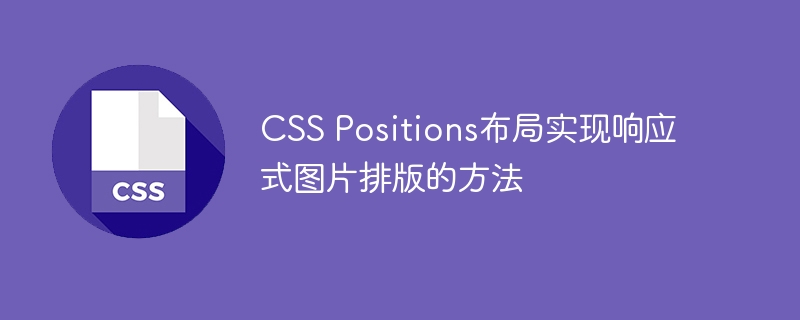

CSS Positions layout method to implement responsive image layout
In modern web development, responsive design has become an essential skill. In responsive design, image layout is one of the important considerations. This article will introduce how to use CSS Positions layout to implement responsive image layout and provide specific code examples.
CSS Positions is a layout method of CSS, which allows us to position elements arbitrarily in the web page as needed. In responsive image layout, we can use CSS Positions to achieve adaptive size and position of images.
First, we need to insert an image tag into HTML. Suppose we have a container div for an image, which can be implemented with the following code:
<div class="image-container"> <img src="image.jpg" alt="图片"> </div>
Next, we need to use CSS Positions to set the width and height of the image and adapt it to the size of the container. You can use the following CSS code:
.image-container {
position: relative; /* 设置容器为相对定位 */
width: 100%; /* 设置容器宽度为100% */
height: 0; /* 设置容器高度为0 */
padding-bottom: 60%; /* 设置容器的padding-bottom为图片高度的百分比,可以根据需要调整 */
}
.image-container img {
position: absolute; /* 设置图片为绝对定位 */
top: 0;
left: 0;
width: 100%; /* 设置图片宽度为100% */
height: 100%; /* 设置图片高度为100% */
object-fit: cover; /* 图片自适应容器大小 */
}In the above code, we set the image container to relative positioning and set its width to 100%. Then, set the container's height to 0 and use padding-bottom to determine the percentage of the container's height. The 60% set here is an example value and can be adjusted according to the actual situation.
Next, we set the positioning of the image to absolute positioning, and set its width and height to 100%. Finally, use the object-fit attribute to make the image adapt to the size of the container, so that the image will be scaled and cropped according to the size of the container to adapt to different screen sizes.
Through the above code settings, we can achieve a responsive image layout. When the size of the browser window changes, the image will be adaptively adjusted according to the size of the container to ensure the display effect of the image.
It should be noted that the above method is suitable for responsive image layout in most cases. However, if there are special needs, such as maintaining the aspect ratio of the image or performing special scaling effects, further adjustments and modifications may be required.
To sum up, by using CSS Positions layout, we can easily implement responsive image layout. By setting the width and height of the container and image, and using the object-fit attribute to adaptively adjust the size, we can present better image layout effects on different devices.
The above is the detailed content of CSS Positions layout method to implement responsive image layout. For more information, please follow other related articles on the PHP Chinese website!




